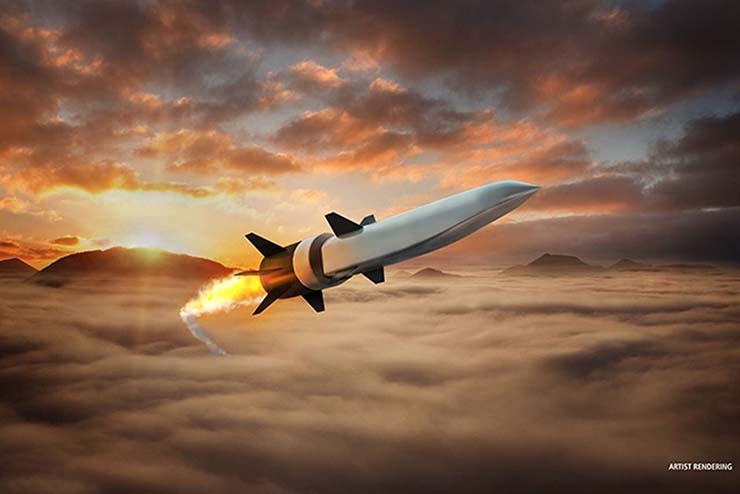
New Delhi: With US, Russia and China competing neck and neck for decades to have missiles that travel at hypersonic speed, generally defined as Mach 5 or greater, the Defence Advanced Research Projects Agency (DARPA) of US announced that it had successfully carried out the second flight test of Raytheon Technologies Hypersonic Air Breathing Weapons Concept (HAWC).
Intercontinental ballistic missiles (ICBMs) meet that definition when they re-enter the atmosphere from space. But because they arc along a predictable ballistic path, like a bullet, they lack the element of surprise. In contrast, hypersonic weapons such as China’s Waverider manoeuvre aerodynamically, enabling them to dodge defences and keep an adversary guessing about the target.
Since the dawn of the Cold War, the Pentagon has periodically thrown its weight behind the development of manoeuvrable hypersonic weapons, only to shy away when technological hurdles such as propulsion, control and heat resistance proved daunting.
“You see a flurry of activity, a lot of investment, and then we conclude it’s a bridge too far,” said aerospace engineer Mark Lewis, director of defence research and engineering for modernization at the U.S. Department of Defence (DOD). “The community was underfunded and largely forgotten for many years,” observed Daniel DeLaurentis, director of Purdue University’s Institute for Global Security and Defense Innovation.
Now, DOD is leading a new charge, pouring more than $1 billion annually into hypersonic research with the motivation for this being the competition from China and Russia and even though the programme has been largely kept under wraps, all three nations appear to have made substantial progress in overcoming key obstacles, such as protecting hypersonic craft from savage frictional heating.
The hypersonic cruise missile, running at five times more speed than the speed of sound, is presently the fastest missile in the world. HAWC missiles are powered by a scramjet engine, designed to perform in the extreme conditions experienced by hypersonic weapons as they travel and manoeuvre at speeds above Mach 5. The test occurred in early July, and the agency said in a July 18 statement it expanded its understanding of the weapon’s engine capability and met all of its test parameters.
“This most recent test allowed exploration of more of the flight and scramjet engine operating envelopes,” program manager Andrew Knoedler said. “DARPA demonstrations are always about learning, whether it’s in the interest of feasibility or practicality, and this time we certainly got new information that will further improve performance.”
Surely not to be left behind in the race for hypersonic missile, India joined the club when in 2020, DRDO successfully tested a Hypersonic Technology Demonstrated Vehicle (HSTDV). During the tests, hypersonic air-breathing scramjet technology was demonstrated.
India has developed its own cryogenic engine and has demonstrated in a 23-second flight. There are plans to make a hypersonic cruise missile using HSTDV. Hypersonic weapons systems with medium-to-long range capabilities are also expected to be available in the next four years.
Raytheon and Lockheed Martin are both developing HAWC prototypes through a joint effort between DARPA and the US Air Force. Lockheed’s missile had its first test in March, but the program has not yet confirmed a second flight. Northrop Grumman developed the engine for Raytheon’s missile, while Aerojet Rocketdyne developed Lockheed’s.
Raytheon’s President of Air Power Paul Ferraro said in a July 19 interview at the Farnborough Airshow the company’s approach to HAWC development relies heavily on digital engineering and high-fidelity models to better understand its missile’s response to the environment before it takes flight.
That’s especially important for hypersonic missiles because the extreme environments in which they operate can cause them to deform or change shape during flight, which affects their performance. Ferraro said Raytheon has advanced its modelling to the point that it can use testing history to create a more comprehensive understanding of the missile’s attributes.
That degree of foreknowledge about the system’s performance is a paradigm shift, Ferraro said. “What we used to do is test to learn about the design,” he said. “Now, we more or less test to validate our models, and that’s where our real learning and design information comes from.”
Having better models also means the government can shift more of its validation work into the digital environment, helping alleviate constraints on flight-test infrastructure, Ferraro said.
As DARPA collects data from the early July HAWC test, the agency is making plans for the program’s next phase, which it announced in its fiscal 2023 budget request. DARPA requested $60 million for the new-start effort, called MoHAWC, to support continued technology development, pay for long-lead component procurement for four more flight-test systems and fund risk reduction for assembly, integration and ground testing.
There is a range of possible applications for scramjet engines, including missile propulsion, hypersonic cruiser propulsion, and part of a staged space access propulsion system. Contrary to rockets, scramjets do not
require that an oxidizer be carried on board the aircraft as it is an air breathing engine, collecting oxygen from the atmosphere. This decreases the required weight of the overall propulsion system and fuel, resulting in a higher allowable payload weight or increased range. There are other reasons that the development of the scramjet is advantageous as well. Air breathing engines produce higher engine efficiency, have a longer powered range, possess the ability for thrust modulation to ensure efficient operation, have higher manoeuvrability, and are completely reusable.
The goal of scramjet development is to give hypersonic vehicles a more efficient alternative to rockets. The vehicle that could most quickly benefit from current scramjet research is the cruise missile; however, a hypersonic cruiser aircraft that is an alternative to traditional turbojet transportation for civilian or military application could also be a not-too-distant possibility. Scramjets could also be used in conjunction with rockets for space launchers, thereby requiring less on-board oxidizer for transport to space.








